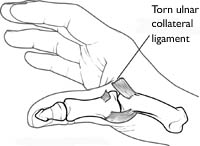
Sprained Thumb
A stable thumb is very important for pinch and grasp activities. A thumb sprain is an injury to the main ligament in the thumb. Ligaments are soft tissue structures that connect two bones to make a stable joint.
If you tear the main ligament (ulnar collateral ligament) at the base of your thumb, your pinch and grasp ability will be weak.
CauseWhen you fall, it is natural to extend your arms to reduce the impact from hitting the ground. The way you land on your hand can stretch or tear the ulnar collateral ligament.
A spill on the ski slopes with your hand strapped to a ski pole can also injure your thumb. When this is the cause of the sprain, it is often called a "skier's thumb."
Symptoms In this sprain, the ulnar collateral ligament is completely torn and may require surgery to heal.
In this sprain, the ulnar collateral ligament is completely torn and may require surgery to heal.
A sprained thumb weakens your ability to grasp items between your thumb and index finger. There may or may not be pain right away. Other symptoms include bruising, tenderness, and swelling.
See a doctor as soon as possible to ensure that the injury will not cause long-term weakness, pain, and instability.
Doctor ExaminationThe ulnar collateral ligament of the thumb may be partially or completely torn. To help determine this, your doctor will move your thumb in different positions to test how stable your thumb joint is.
TestsYour doctor may suggest x-rays to ensure that the bone is not broken.
A special type of x-ray, called a stress x-ray, shows the joint as the doctor applies tension to the injured ligament. If the test causes pain, a shot of a local anesthetic may help. Your doctor may also take an x-ray of the uninjured thumb to compare it to the injured thumb.
Nonsurgical TreatmentIf the ligament is only partially torn, your doctor will probably immobilize your thumb joint with a bandage, cast, or splint until it heals. To ease pain and swelling, you can place an ice pack on your thumb twice a day for 2 to 3 days after the injury.
For the first 3 weeks after your injury, you will wear the splint or cast at all times. After that, you can take it off to do strengthening exercises for your thumb. The splint should be worn at all other times. This should continue for another 2 or 3 weeks, until the swelling and tenderness in the thumb are gone.
Surgical TreatmentIf the ulnar collateral ligament of the thumb is completely torn, surgery may be needed to regain normal movement. Surgery involves reconnecting the ligament to the bone.
When the ligament tears away from the bone, sometimes fragments of bone are pulled away with it. If this is the case, then during surgery, the bone fragments may be removed or put back into the correct position and fixed with a pin or screw.
After surgery, a short arm cast or a splint will be necessary for 6 to 8 weeks to protect the thumb ligament while it heals.
Long-Term OutcomesA sprained thumb is often ignored with the hope that it will heal itself. If this ligament injury is not diagnosed and treated properly, it may lead to chronic instability, weakness, and ultimately arthritis.
If a thumb sprain leads to these late complications, it may require surgery to rebuild the ligament using tissue from another part of your upper arm. Another treatment option might be a joint fusion procedure.
Source: http://orthoinfo.aaos.org/topic.cfm?topic=A00022
